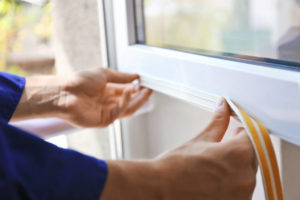by Michel Merkx

Photo courtesy Pressure Sensitive Tape Council
Pressure-sensitive adhesive (PSA) tape technologies have properties that can insulate a building from environmental events such as precipitation, vapor ingress, extreme cold and heat, and external noise. While there may be a temptation to use putties and caulks instead of PSA tapes for insulation purposes, those materials are typically employed as fillers meant to span gaps—they do not provide an air or water barrier. Liquid sealants and mechanical fasteners are often utilized on exposed building surfaces, but PSA tapes can be used as an effective alternative or complementary barrier throughout a building by sealing areas like windows and doors that may be vulnerable to outside environmental fluctuations.
Tape, which is generally thought of as a product binding things together, is actually multifaceted and versatile with usage going beyond its more understood ‘stickiness.’ In other words, tapes are sticky, but are also developed to comprise properties made for specific applications, including barrier and insulation. Various PSA tape backings (e.g. aluminum and multilayer films) can create a vapor barrier to protect the insulation. By using a Class-1 vapor barrier with very low permeability as a backing material, one can extend the life of the insulation system.
The ability of an adhesive to manage environmental stressors—such as temperature range, application temperature, ultraviolet (UV) exposure, expansion/contraction, and moisture (bulk water and vapor)—can be related to both curing and chemistry, writes Paul Ludwig Geiss and Daniel Vogt from the Kaiserslautern University of Technology, in the paper “Durability of Pressure Sensitive Adhesive Joints,” presented at the 2007 Pressure Sensitive Tape Council (PSTC) Annual Technical Seminar.
PSA properties can interact with different surfaces and environments in various ways. Cold temperatures, harsh conditions, or even moisture can adversely affect insulation tape behavior and performance. However, modern technological developments allow PSAs to successfully handle environmental challenges.
Martin Widenbrant, product developer at a tape manufacturer, remarked in his 2016 PSTC technical seminar paper, “PSA Technology and Testing Requirements for Water Vapor Permeable Air Barriers” air barriers have evolved from roofing felt (i.e. tar paper) to waterproofing materials like polyethylene film with modified-bitumen adhesive. While building papers (nonwovens) are water/vapor permeable, the self-adhered waterproofing membranes are water/vapor impermeable.
Widenbrant noted the major advantage with a PSA tape air barrier is installer-made defects (holes, cuts, or tears) are limited to the defect because the adhesive effectively blocks access to the rest of the wall. On the other hand, a mechanically fastened material with holes allows complete access to the wall, thereby reducing the energy savings performance of the air barrier material and insulation.
Another effective way to utilize PSAs as a barrier is to stop additional penetrations with tape, which creates an airtight seal. When overlapping wrap material, one must tape the insulation seams to ensure the barrier is continuous. Chemistry should be considered when employing tape to help keep buildings properly insulated.
Mark Hatch, director of tape and healthcare at a manufacturer of polyolefin substrates, states that when discussing thermal insulation values of materials, two terms are commonly encountered—the K-factor and the R-factor. “The K-factor is referred to as the thermal conductivity and has only one value for a material at a given temperature. It is independent of the sample thickness. The K-factor of a material is determined by a laboratory evaluation,” he says. The R-factor is directly related to thickness and can be calculated by using the K-factor. Thermal conductivity is dependent on density. A rule of thumb for closed-cell foams is, the greater the density, the poorer the insulation value.
This information can help determine what type of PSA tape to use for any given situation.
One main advantage a PSA tape offers is 100 percent surface adhesion, whereas mechanical fasteners can only be held in place where the fastener is located. Other advantages include lower labor and equipment costs, lack of equipment needed, application speed, fewer penetrations, and allowance for some joint movement.
Butyl rubbers and acrylic tapes are the two most common tapes used for barriers. Made from either water or solvent-based adhesives, acrylic tapes are created by polymerizing monomers to create polymers with specific properties. Its use is prevalent in the construction field where insulation is essential. Acrylic tapes provide a reliable seal and have a high level of cohesion. Known for their durability, these tapes work well when seaming vapor barriers and sealing house wraps.
Acrylic polymers are well-known for their weatherability and can be employed in harsh outdoor and indoor environments for years without degradation, unlike many rubber chemistries. Tape used for moisture barriers are made from a range of materials and thicknesses to fit virtually any performance criteria. Butyl tape is developed using a synthetic rubber adhesive. These tapes are designed to be air-impermeable, waterproof, and insulating. Butyl tapes are ideal for seams, providing a watertight bond for optimal sealing. These tapes can conform to irregular surfaces without degrading adhesion strength. Butyl tapes have a high initial tack and are more aggressive on contact. They can also bond to a wide variety of surfaces.
The important objective to keep in mind is if the project calls for a true air barrier, special products on the market offer high-performance. Ultimately, barriers are most effective if installed with all laps, seams, penetrations, and terminations completely sealed. Following a tape manufacturer’s instructions ensures a project is safe from air penetration for years to come.
 Michel Merkx is vice-president for the global tape division of American Biltrite. He brings his knowledge and expertise about pressure-sensitive materials, production processes, labels, and various market trends to his current role as the president of the board of directors for the Pressure Sensitive Tape Council (PSTC). Merkx holds an MA in international business management and an MBA. He speaks Dutch, English, French, German, and Spanish. Merkx can be reached at info@pstc.org.
Michel Merkx is vice-president for the global tape division of American Biltrite. He brings his knowledge and expertise about pressure-sensitive materials, production processes, labels, and various market trends to his current role as the president of the board of directors for the Pressure Sensitive Tape Council (PSTC). Merkx holds an MA in international business management and an MBA. He speaks Dutch, English, French, German, and Spanish. Merkx can be reached at info@pstc.org.




